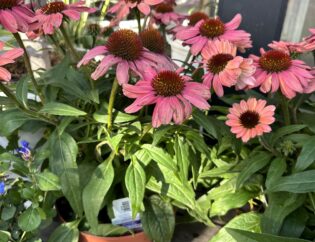Even with the gloomy, overcast skies and the chill of winter, there are still plenty of compelling reasons to indulge in gardening! A selection of resilient herbs can flourish in our climate, providing fresh flavors and aromas that can be harvested throughout the year. Embracing these hardy varieties not only brightens the winter landscape but also enhances our culinary creations, turning any dreary day into an opportunity for growth and nourishment.
But first, here are a few reasons to grow your herbs in the garden:
- The freshest herbs you can find are straight from your backyard
- Herbs grown at home become way less expensive than store-bought in the long run
- You can “cut and come again” as many times as you’d like (and year-round) once the plants are established
- Homegrown herbs taste better
- Herbs are one of the easiest plants to grow, making them accessible for even the self-proclaimed “black thumb.”
Rosemary
Rosemary is a must-have in every kitchen garden. Once established, it is very easy to grow and drought-tolerant. It prefers well-draining soil and needs full sun. Rosemary can be grown in containers or in the ground. A rosemary topiary can be a lovely formal addition to a patio.
Rosemary needs little to no pruning—only when the plant becomes too large for the space or if you’d like to shape it into a topiary. This herb is very popular for cooking poultry, bread, and vegetables.
It is an evergreen shrub, meaning it keeps its leaves all year. In the winter, you may find that your Rosemary shrub will be covered in lovely purple flowers.
Rosemary is straightforward to dry and preserve. Cut a few branches and tie them with twine. Hang them to dry in a cool, dark, and dry space. Once completely dried, chop the leaves very finely and store in an airtight container.
Lavender
There are many types of Lavender to grow in the garden, but English Lavender (Lavandula angustifolia) varieties are the best suited for culinary use. ‘Munstead’ and ‘Hidcote’ are great for drying and consuming the flowers.
Lavender can be used in beauty products such as soaps, lotions, and oils. For culinary purposes, create your own “Herbs de Provence” blend for poultry and fish. Another favorite culinary use is Lavender Simple Syrup for beverages.
Lavender is a Mediterranean plant and prefers well-draining soil. It can be grown in a container or in the ground. To prune, shape the plant by cutting 1/3 of the plant once the blooms are spent or harvested.
To get the best benefits from Lavender, cut fresh flowers before the buds completely open. Hang it to dry and store it just like the Rosemary mentioned above.
Thyme
Thyme is another herb that can be grown year-round. It is used for culinary purposes in soups, meats, vegetables, and pastas. There are many types of Thyme, such as Lemon Thyme, which has a more lemony scent, and creeping Thyme, which is an excellent, low groundcover.
Thyme is one of the easiest herbs to grow. Harvesting regularly will help create a dense and attractive plant. Harvest only 1/3 of the plant at a time. Enjoy pink/purple flowers in spring and summer. Thyme needs at least 6 hours of full sun to make a vigorous plant.
Thyme is a great kitchen garden plant for its attractive shrubby habit. You can plant it in containers with other herbs to create a beautiful arrangement.
Oregano
 Oregano is another perennial herb that tastes great in soups or with meats. It is also a classic herb used in Italian dishes. It forms a very attractive little shrub that can be shaped when harvesting. Just like Thyme and Lavender, prune only 1/3 at a time.
Oregano is another perennial herb that tastes great in soups or with meats. It is also a classic herb used in Italian dishes. It forms a very attractive little shrub that can be shaped when harvesting. Just like Thyme and Lavender, prune only 1/3 at a time.
Oregano needs well-draining soil, so be sure there are suitable drainage holes if you plant in a container. It also requires at least 6 hours of full sun to grow to its proper shape. Enjoy white to purple flowers in summer! The flowers make this plant a great pollinator attractor.
To dry Oregano, prune a few stems and hang them upside down or store them in a cool, dry, dark place until fully dry. Then, finely chop and store in an air-tight container.
Mint
Mint is a vigorous perennial herb that is one of the easiest plants to grow in the garden! In fact it is so easy that it may spread in places you don’t want it to. To combat this issue, confine the plant in a container and never plant it in the ground.
Mint is an excellent herb in cocktails, simple syrups, and fruit salads. It adds a refreshing flavor that brightens up any recipe. Many different mints are available depending on the time of year, such as Chocolate Mint, Spearmint, and Peppermint.
It is also a very easy herb to propagate and share with others. Cut a stem of the plant and remove the lower leaves. Place in a vase or small glass of water until roots form. Then, plant the mint in soil and water immediately.
I hope you feel inspired to start a year-round herb garden! Herbs can be incorporated into many recipes and used in various at-home products, offering endless possibilities. Please visit our nursery to see the selection of herbs we have in stock. Happy gardening!





